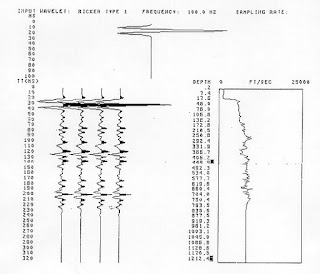
Figure 28 – Marine Seismic Acquisition
In marine seismic surveys, a shock wave is created by the following:
· Compressed-air gun - shoots pulses of air into the water (for exploration over
water)
The reflections of the shock waves are detected by sensitive microphones or vibration
detectors (hydrophones) over water.
Although modern oil-exploration methods are better than previous ones, they still may
have only a 10-percent success rate for finding new oil fields. Once a prospective oil
strike is found, the location is marked by marker buoys on water.
Seismic records and the synthetic seismogram
Seismic energy sources used by the energy industry are required to generate reflections
from rock units several thousand feet below the surface, and so typically have frequencies
of the order of 30 Hz. A simulation of a field record of this type is shown in Figure 1.
This synthetic seismogram was computed using a sonic log recorded in a Dakota Aquifer
program observation well in Ellis County.
Notice that the depth scale is not measured in feet but in units of two-way travel time in
seconds that record the time that elapsed between the triggering of the energy source and
the arrival of the reflection at the geophone. Because the sound velocity changes
continuously with depth the time record is not a simple transformation of depth. The
reflection peaks (black) pick up rock boundaries where the acoustic velocity increased
downwards going from a "slow" shale to a "faster" limestone or sandstone, while the
reflection troughs (white) match the reverse situation.
The 30 Hz frequency of the energy source results in a fairly coarse resolution, so that
only fairly thick rock units with strong impedance contrasts can be distinguished. This
characteristic can be seen in Figure 1, where the stratigraphic units are resolved easily,
but reflections generated by the sandstones within the Dakota Aquifer tend to overlap and
merge.
Figure 29. Synthetic seismogram for the Dakota aquifer and adjacent stratigraphic units,
calculated from geophysical logs in the observation well KGS Braun #1 (NENENE 30-
12S-18W), Ellis County, Kansas.

Better precision can be obtained by high-frequency seismic shooting of Dakota Aquifer
sections where they are fairly close to the surface. Coyle (1990) made several field
studies in the vicinity of Dakota Aquifer program observation wells to evaluate the
feasibility of seismic methods in the location of channel sandstones. Sonic logs at the
wells could be used to create synthetic seismograms, so that interpretations of field
records could be correlated with geology.
Gamma-ray and sonic logs are shown from a second observation well in Ellis County
(Figure 30). The sonic log was converted to a two-way reflection time record of velocity,
which was then transformed to a train of reflection coefficients and convolved with a 100
Hz Ricker wavelet (Figure 31). By superimposing the synthetic seismogram at the
observation well location on the East-West seismic line (Figure 32), the field reflections
can be related to specific geological features. The Stone Corral provides a strong reflector
that is easily recognized on seismic records from the entire region

Figure 30. Gamma-ray and sonic logs from observation well KGS Brungardt #1
(SESESE 25-12S-17W), Ellis Co., Kansas.
The contact between the Dakota Formation and the underlying Kiowa Shale can be seen ,
and is caused by the sharp change in velocity at the contact (see Figure 30). Reflections
from the Greenhorn Limestone, Graneros Shale, and the top of the Dakota Formation can
also be identified on the field record from their signatures on the synthetic seismogram.
The distinctive and laterally continuous reflection at 0.26 seconds was interpreted to
coincide with the top of the Permian.

Figure 31. Comparison between the synthetic seismogram computed from the Brungardt
well sonic log (see Figure 3) and a field seismic line shot at the well site (from Coyle,
1990)
Coyle concluded that while thin sandstone lenses within the Dakota would not be
detectable at this frequency (100 Hz), modeling suggested that sandstones thicker than 30
feet would be resolvable. A field seismic line shot over a Dakota channel sandstone at
another site gave some support to his conclusion (Figure 5). Thinner sandstones could be
identified where reflections were recorded with frequencies higher than 180 Hz. The
resolution and quality of seismic records were also found to be site dependent. The best
sites were located on fresh exposures of Graneros Shale, where reflections of 200 Hz and
higher were recorded. The worst sites occurred on the Greenhorn Limestone outcrop,
while low frequencies were recorded at levels higher than the Greenhorn.

Figure 32. CDP seismic section tied to Dakota Aquifer program observation well KGS
Haberer #1 (NESENE 14-12S-15W), Russell County, Kansas. Note channel sandstone.
From Coyle, 1990.

Figure 33 – Seismic Section
No comments:
Post a Comment